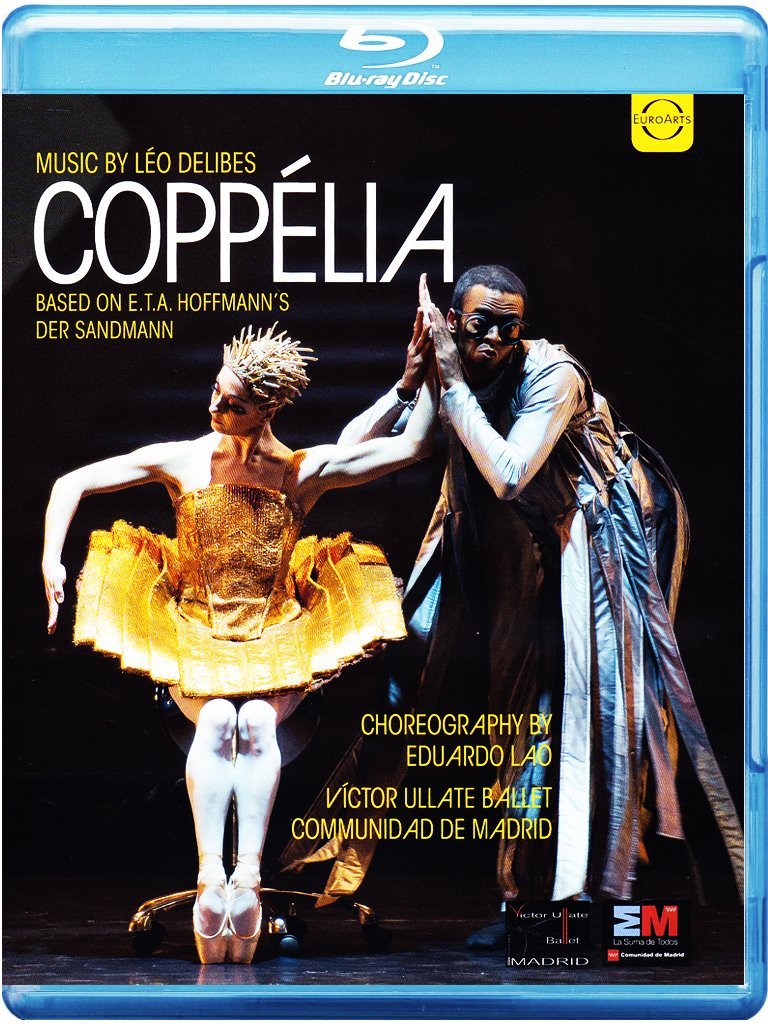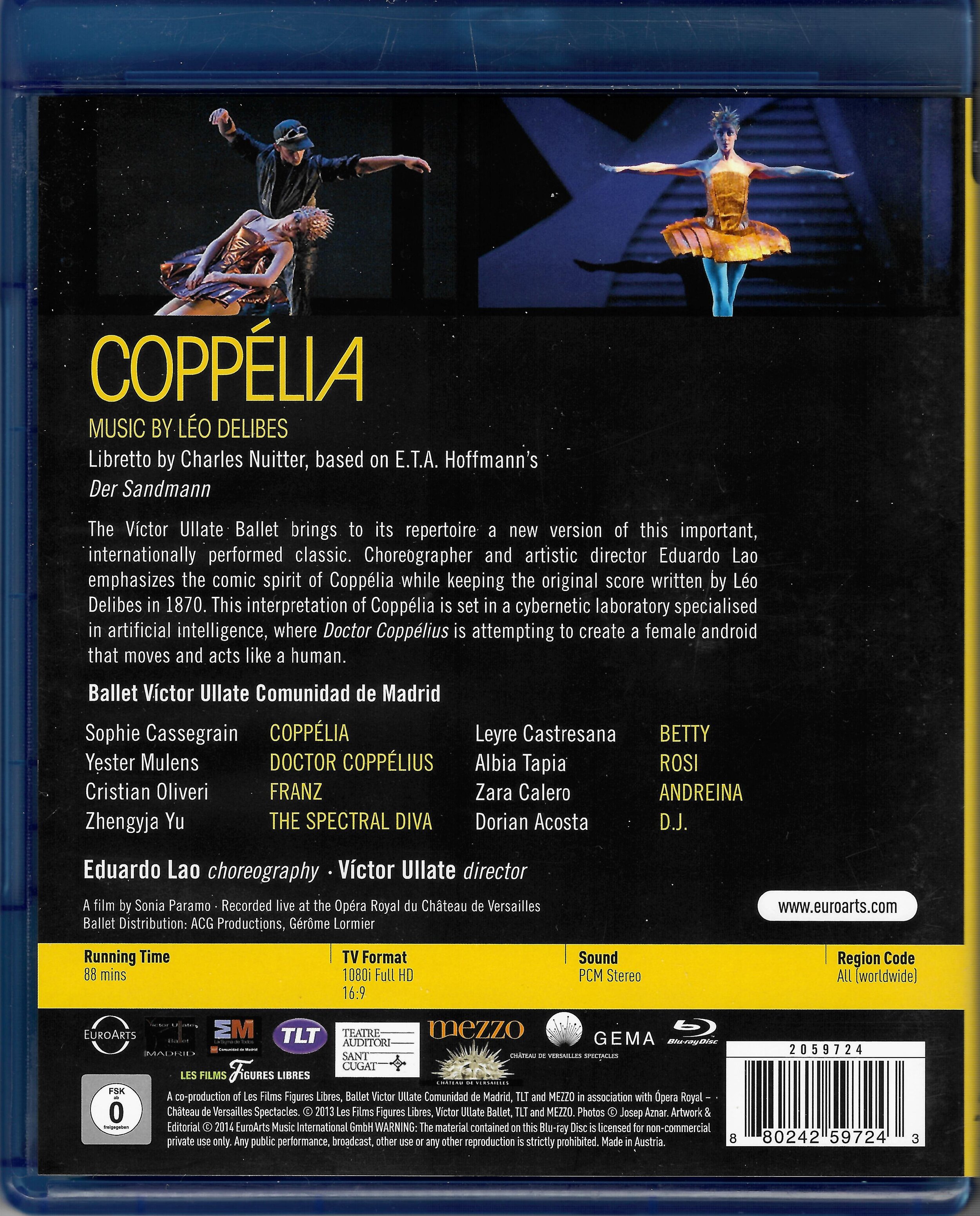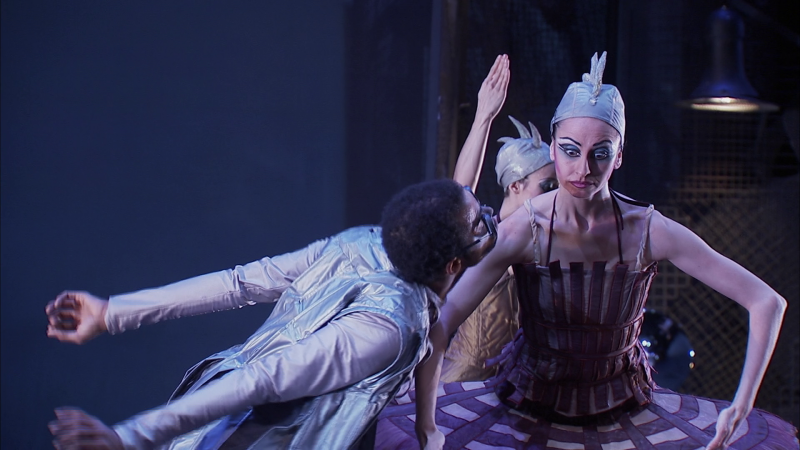

Coppélia modern ballet to music by Léo Delibes. New libretto and choreography by Eduardo Lao; production directed by Victor Ullate. Performed at the Opéra Royal du Château de Versailles. Stars Sophie Cassegrain (Coppélia), Yester Hulens (Doctor Coppélius), Cristian Oliveri (Franz), Zhengyia Yu (The Spectral Diva), Leyre Castresana (Betty), Albia Tapia (Rosi), and Zara Calero (Andreina) [the 3 Cleaning Ladies], and Dorian Acosta (DJ). Other dancers of the Victor Ullate Ballet Comunidad de Madrid are Ksenia Abbazova, Federica Bagnera, Marlen Fuerte, Laura Rosillo, Reika Sato, Lorenza Agramonte, Mariano Cardano, Mikael Champs, Matthew Edwardson, Oliver Edwardson, Jonatan Luján, Andrew Pontius, and Josué Ullate. Set by Carlos Pujol; lighting designed by Nicolas Fishtel and executed by Tatiana Reverto; costumes designed by Pedro Moreno. Directed for TV by Sonia Paramo.
EuroArts PR, the keepcase, and the keepcase booklet fail to mention that this ballet was produced and performed in 2006, about 8 years before it was released as a video. It was apparently performed to a recording of the Delibes Coppélia ballet score by an uncredited orchestra. Released 2014, the disc has PCM stereo sound only If this were a classical production, we would exclude it for stereo sound only. But we do cover modern dance productions in stereo. Grade: C
Coppélia is one of the most beloved ballets. Children love it. It's also popular with smaller and student companies. The story has a moral for young people. Franz is supposed to marry Swanilda, but he falls for the more beautiful Coppélia. When she turns out to be a doll, Franz learns not to look for greener pastures. Swanilda takes Franz back. They have their wedding and everybody dances for the rest of the evening.
The original Coppélia calls for a large corps of dancers. But smaller companies come up with pint-size versions, and this Eduardo Lao concoction is one of them. What a deal. You get the wonderful original music for free. And you don't have to pay an orchestra to perform live. The rights to recordings already done can be had at low cost. The name Coppélia is free. So all you need is some choreography and a ballet company to perform your new spin on things. If it's a hit, you might make some money at the theater. And then maybe you can show it on TV, and even make a DVD or HDVD. Well, in reality, making money this way is excruciatingly hard to do, but people keep trying.
Now for some screenshots. The time is in the future, and we are in a factory. Dr. Coppélius ("Dr. C" for short) has invented a beautiful female human automaton to be sold as housekeeper, cook, and companion. She works ceaselessly and never complains, all the while dressed as a ballerina or fashion model, i.e., a robowife!
It's after hours. Franz is the janitor, and he supervises three human cleaning ladies, Betty, Rosi, and Andreina (" B/R/A") for short (you can't tell who is who.)* The factory has a no-smoking rule:
Some of the factory workers are pulling overtime working on the latest robowife units:
The most beautiful robowife made so far is named Coppélia for her inventor. Coppélius has a crush on her:
This Coppélia film was made in 2006. At that time, everyone knew that HD TV was coming, but HD video cameras were expensive. The 3 cameramen had 2 HD cameras and one old SD model. The SD camera was assigned to the whole-stage shots. To keep the viewer from noticing the fuzzy SD images, whole-stage shots were used sparingly and kept as short as possible. Here's an example:
B/R/A got bored. They found some robowife outfits and decided to have fun cross-dressing. Dr. C is confused:
Soon B/R/A are mixing in with the robowives. The humans are trying to act like robots and the robots are trying to act like humans. All of them are real fuzzy in this SD shot of the whole stage:
Franz goes looking for B/R/A and meets Coppélia. He falls in love at first sight:
Coppélia wants to know what human love is (have you ever encountered this plot element before?). A magical Spectral Diva takes pity on Coppélia and starts training her:
Coppélia becomes a real woman, and Franz is really hooked. That's it friends: a dash of Rusalka/The Little Mermaid/Ondine and a pinch of Cinderella, and Act 1 is over. Is there anything original about this? I don't think so --- at best, it's a pastiche of standard ballet themes. So how does Coppélia get out of the factory? Find out in Act 2:
Another standard ballet theme is the big (birthday, coronation, wedding, or pick-a-princess-for-a-wife) party where everybody gets to dance. In this Coppélia knock-off, the party is a PR event where Dr. C will announce the invention of the robowife. Here we see the elite guests and a DJ who will entertain them (there are only 21 dancers in this show, so the large stage always looks thinly populated) :
In the meantime, Franz gave B/R/A fancy dresses from the factory showrooms:
Poor Coppélia gets introduced as the first robowife. Only she and Franz knows that she's really a human now. Coppélia pretends she's still robo:
Franz also found some sexy clothes in the showroom. Everyone is astonished when he assaults Dr. C:
Act 2 turns out to be a repeat of Act 1. The Spectral Diva appears again, this time to run off Dr. C:
Coppélia and Franz dance a nice pas de deux:
So Dr. C loses his first robowife. But don't worry: there are others on the assembly line. And B/R/A are all crazy about him:
I think it's tad presumptuous for one to take such a thin libretto as this, give it the famous Coppélia name, use the Delibes music, and then then call it "a new version of [the] internationally performed classic." There is no justice in civil or criminal law for this sort of puffing---so the only remedy left is ridicule. There's nothing wrong with the robowife idea. But for Lao/Ullate to make this original, they would have to come up with a new name such as "Escape from the Robowife Factory." Then they would have to commission some modern music. The libretto would include things like nudes on the assembly line, picketing by the Female Liberation Union, and sexual harassment by lecherous members of the factory board of directors. Coppélia wouldn't marry the janitor--- she would declare herself unisex and go on to build an entertainment empire on Internet TV. OK. That's enough ridicule. Back now to our review.
The best thing about subject title is the stereo soundtrack with better than decent SQ. The keepcase booklet has a list of the tracks on the disc and how they relate to the Delibes music. The costumes are pretty. The single set and lighting, although tacky-looking now, work well enough.
But every thing else about this title is disappointing. We already said enough about the libretto and the fact that all the full-stage shots are DVD quality. The sound should have been in surround format, not stereo. The dancers don't seem sharp or well-rehearsed. They also seem lonesome on the big stage. With only two HD cameras available, it's not surprising that the video often seems frantic and disjointed.
The keepcase package states that the film recorded "live." But the impression the viewer gets is that the show was recorded on a stage in an empty house. During the whole show there is not a single clap, laugh, or cough. (If you use recorded music, why make a sound recording of the performance at all?) There is no video shot made during the show that connects it to a live venue. Careful observation reveals that a lot of editing was done of the film. This is especially evident in Act 2. The flow of dancing on center stage moves along smoothly. But if you watch the dancers at rest in the rear of the stage, especially those sitting on the sofa, you see little continuity. This suggests that clips from several, maybe many takes, were used in the final product. Although the dancers do smile a lot, I do not sense much of the energy and zest in performance that is supposed to infuse a live show. After conclusion of the show there is, however, a curtain call. Once again there is nothing in the video content to tie this to the alleged live venue. But suddenly you do hear tepid, weak applause from a crowd that shows little enthusiasm for the performers. It's impossible to know the truth about how this film was made, but the impression I get is that performance in Paris (away from the Madrid homebase for the ballet company) was a flop.
The poorly-written EuroArts keepcase booklet is worse than worthless. It doesn't have a synopsis to explain the action in the new libretto. The tract list does nothing to help you understand the story. And the booklet obscures information about the date of the film in what may be an attempt to make something old and stale appear to be new and exciting. I originally gave this a D. Maybe that was too snide. I’ll call it a C, which is probably generous.
*Special credit: the first screenshot above comes from Leonard Norwitz in his careful review of Coppélia on his lens-views.com website. See the Norwitz review for more discussion of the photography in this Coppélia. Norwitz winds up with a C+ grade.
OR

















